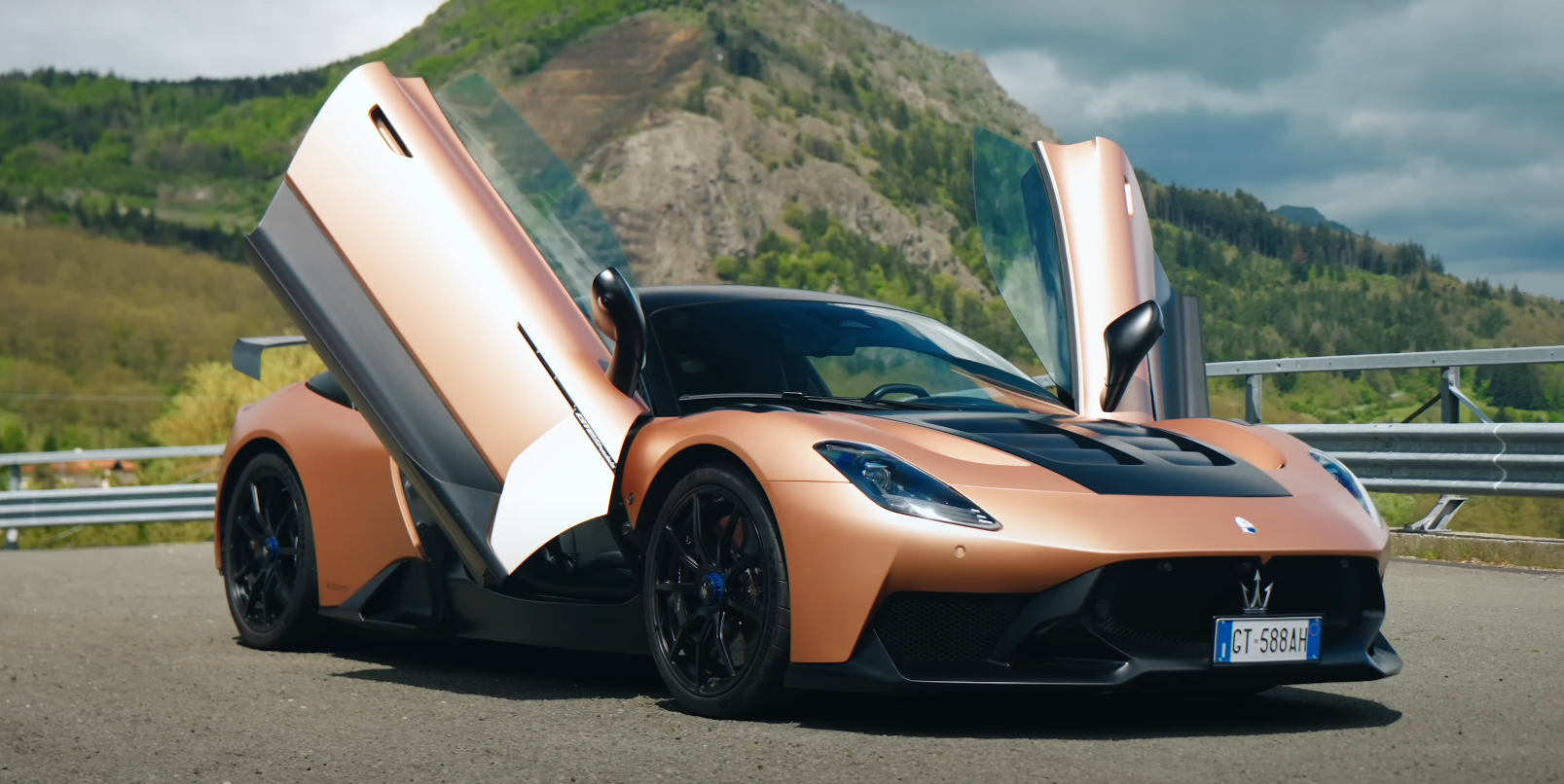Before we climb behind the wheel of the latest supercar out of the gates of the Maranello factory in Italy, it’s as well to remind us of just where the inspiration for the 296 GTB’s design inspiration came from.
This was in the autumn of 1963 when Enzo Ferrari presented the Scaglietti-styled mid-engined 250LM coupé at the Paris Show. This serious-looking automobile was basically a berlinetta version of the 250 P prototype racer, but Enzo had an audacious scheme. He wanted to enter the 250LM in endurance races in the ‘production’ GT category, particularly the 24 hours of Le Mans (hence the car’s name), but to do so, he had to build 100 examples.

In April 1964 he applied to the sports legislators, the FIA’s Commission Sportive Internationale, but after admitting that he had only produced 10 cars they sent him packing. The old fox tried again in July and a delegation of the FIA committee travelled down to Italy where they saw (with a certain imaginative effort) evidence of 37 cars in total, each of which would have cost around $22,000, about three and half times the price of a Cadillac Fleetwood Eldorado in the US at the time. Again, the FIA said ‘non’.

“Enzo Ferrari went berserk,” wrote Brock Yates in his book Enzo Ferrari – The Man, The Cars, The Races. He swore he’d never race in Italian colours again, handed in his race licence and fielded his cars in the blue-and-white colours of North America. He only ever built 32 250LMs, yet in some ways, that controversy set the die for this car. In 1965 a NART-run example in the hands of Jochen Rindt and Masten Gregory won the 24 hours of Le Mans, with another example coming in second.
Even today, Ferrari’s notorious 250LM is contentious when it appears on track against contemporaries; it was that good.
Inspired by a racing past
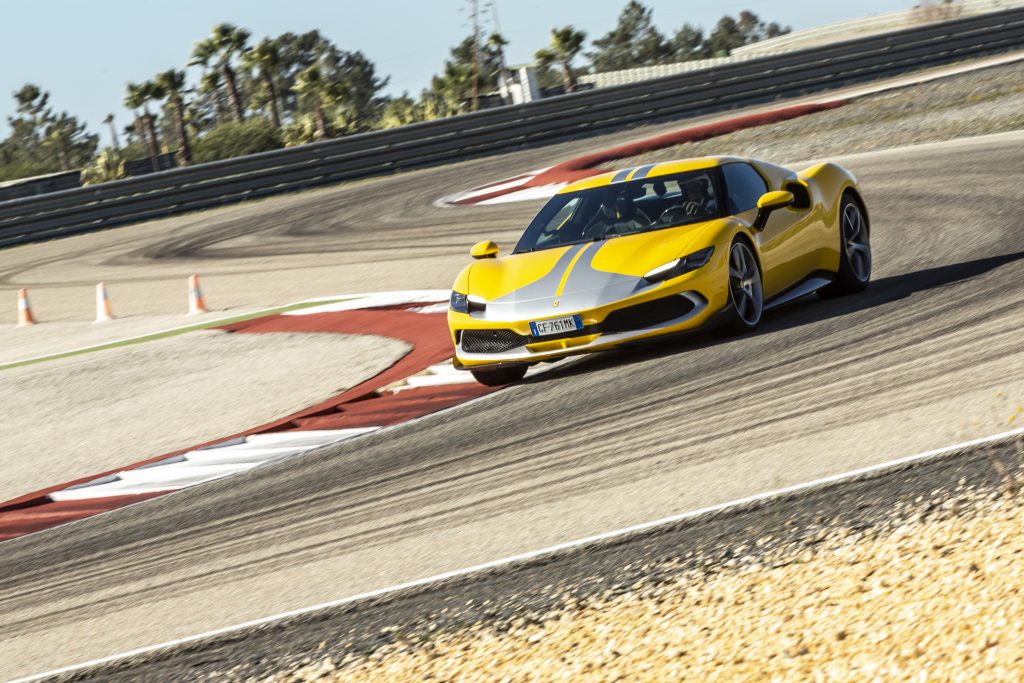
So, when the resolutely forward-looking design department at Ferrari says it has found inspiration in a near 60-year-old race car, you have to wonder a bit, yet that’s exactly what Flavio Manzoni, Ferrari’s vice president for design says of this extraordinary new plug-in hybrid, V6 Ferrari, the 296 GTB. And looking around the aluminium body of this quarter of a million-pound machine, you can certainly see the truth in the statement. Those rear wings, that cut-off roof line, the Kamm tail and the windscreen line; you can see the links to the 250LM, but then Manzoni draws back: “that doesn’t mean we have looked back,” he says inscrutably.
If you stood the two cars together, though, 250LM next to 296GTB, you’d be shocked at the size of the latter. At 4,565mm long, 1,958mm wide and 1,187mm tall, it’s almost half a metre longer than the V12-engined 250LM, 258mm wider and 72mm taller (it’s also, at 1,560kg in standard road trim, with a full tank of fuel, almost twice as heavy.
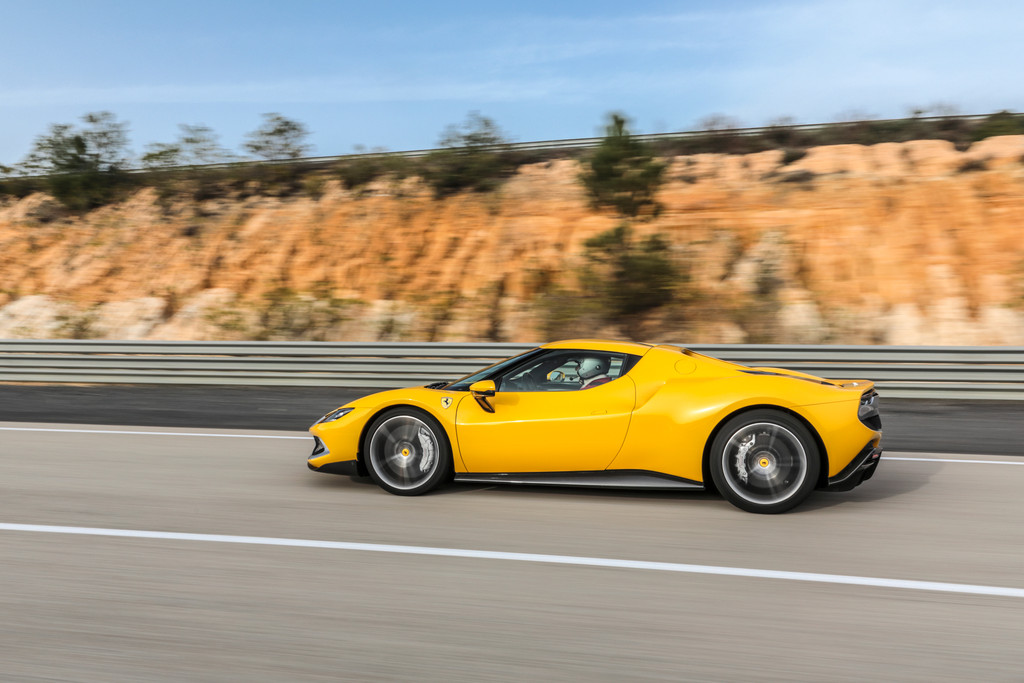
Yet that’s the way with modern cars and their crumple zones and wide tyres, and while the 296 GTB’s V6 engine saves some space, there’s also the plug-in hybrid to package and add heft and size. Ferrari asserts that the 296 GTB is compact because of its short wheelbase, although in fact it’s only 46mm shorter and 21mm narrower than the F8 Tributo which it replaces.
Ferrari’s first V6
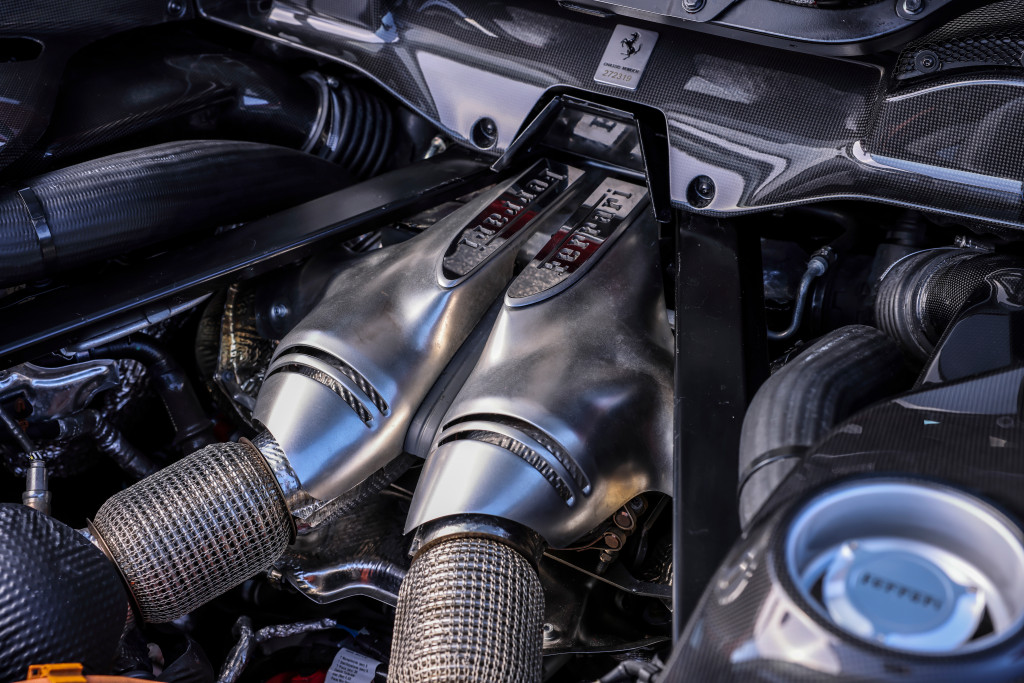
Did I mention the V6? This is the first V6-engined car to be badged as a Ferrari. The 1967 to 1974 V6-engined Dino series didn’t carry Ferrari badges and the company’s first V6, the 65-degree, 1.5-litre unit was in a race car, the 1957, Dino 156 monoposto – they might have won him races, but Enzo didn’t much like V6s.
This 654bhp, 120-degree V6 is a short-stroke, twin-turbocharged screamer, with the turbos sitting in the vee of the engine and the induction systems on the outside. Ferrari says it’s 30kg lighter than the V8 it replaces, though the hybrid system weighs 170kg.
Adding to the combustion engine’s efforts is a 6kWh net, 73kg lithium-ion battery running across the back of the seats, with a 164bhp Formula One-derived electric motor sitting between the engine with its own clutch so it can drive the car on its own, albeit for a measly 15.5 miles (probably not even enough to get you to your local Ferrari dealer) at speeds up to 84mph, though not necessarily at the same time. It uses an eight-speed, twin-clutch transmission driving the rear wheels.
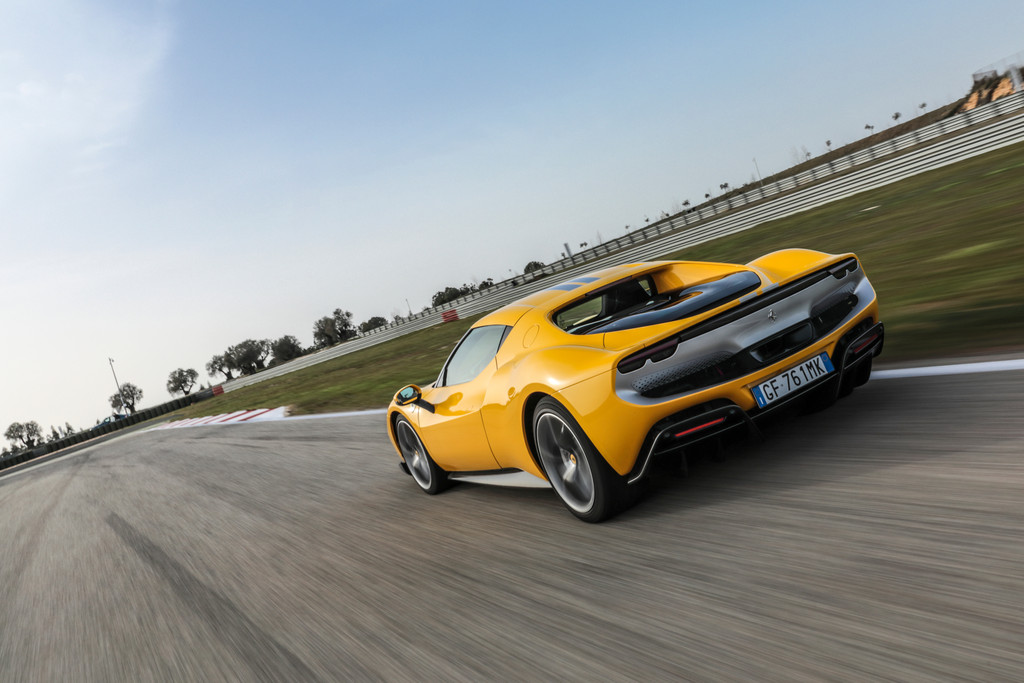
As you’ll have already guessed, the combined thrust of the V6 and electric motor makes for hold-on-tight performance. Top speed is quoted at 205mph, with 0-62mph in 2.9sec and – get this – 0-124mph in 7.3sec. Fuel consumption is 21.7mpg on the Combined WLTP cycle and CO2 emissions are 149g/km, which given the optimistic PHEV test cycle, shows that the hybrid system is there to add to performance rather than reducing environmental impact.
Not particularly coincidentally, this is almost exactly the same configuration and drivetrain chosen by McLaren for its new Artura supercar and it’s unsurprising that the £185,500 Woking-built car has very similar performance characteristics to the £241,550 Maranello-built car.
The inside story
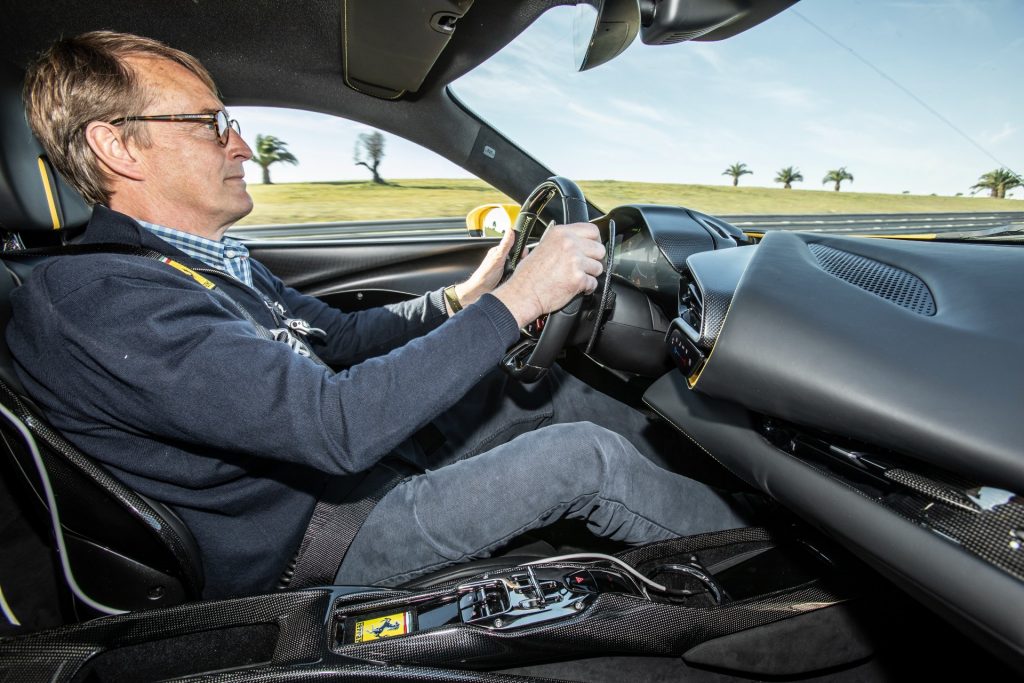
Bending down and climbing into the cabin is a bit of a trial, but once ensconced, there’s more space than you might expect. The 113-litre shelf above the battery behind the seats provides a useful storage area for small bags and there’s room for a couple of airline carry-on bags under the 201-litre front ‘boot’. The optional leather-upholstered carbon-fibre shell seats aren’t the last word in comfort, though, with an over-eager lumbar support.
Views out are pretty good to the front despite the thick windscreen pillars, but to the rear, the door mirrors are filled with the rear-wing air intakes and the views over the cut-off tail in the rear-view mirror aren’t the most panoramic. The driving position adjusts for most heights and the impression is of a car ready for action, but there’s no sense of where the rear body ends so you rely heavily on the parking sensors.
The fascia is a combination of glassy instrument binnacle with all-digital switches and displays combined with the improbable luxury of a tan leather floor – yes, really.
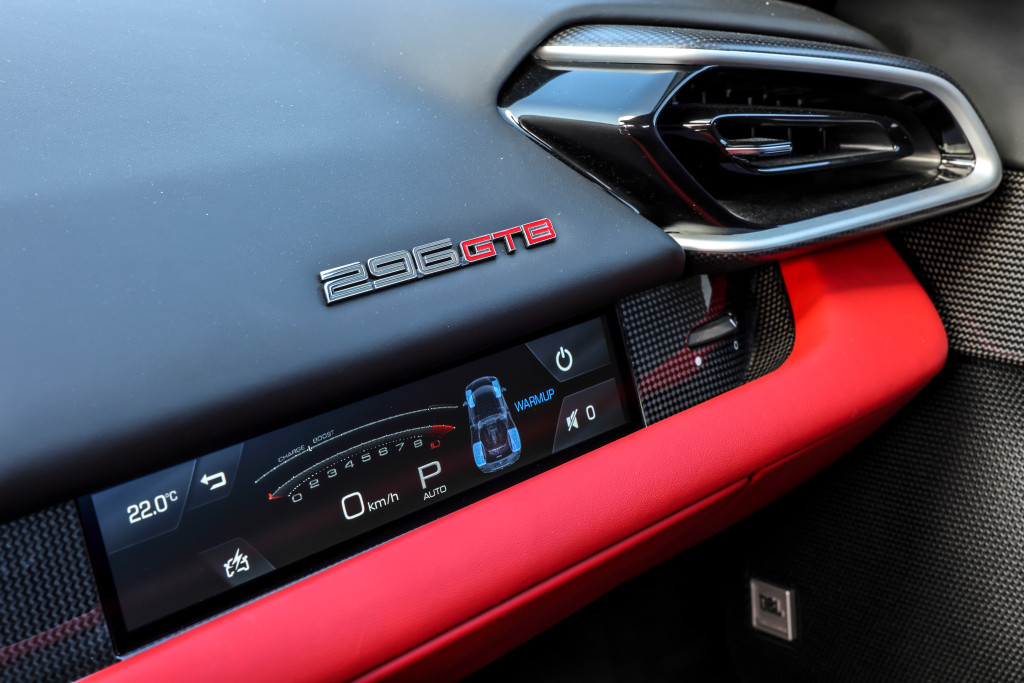
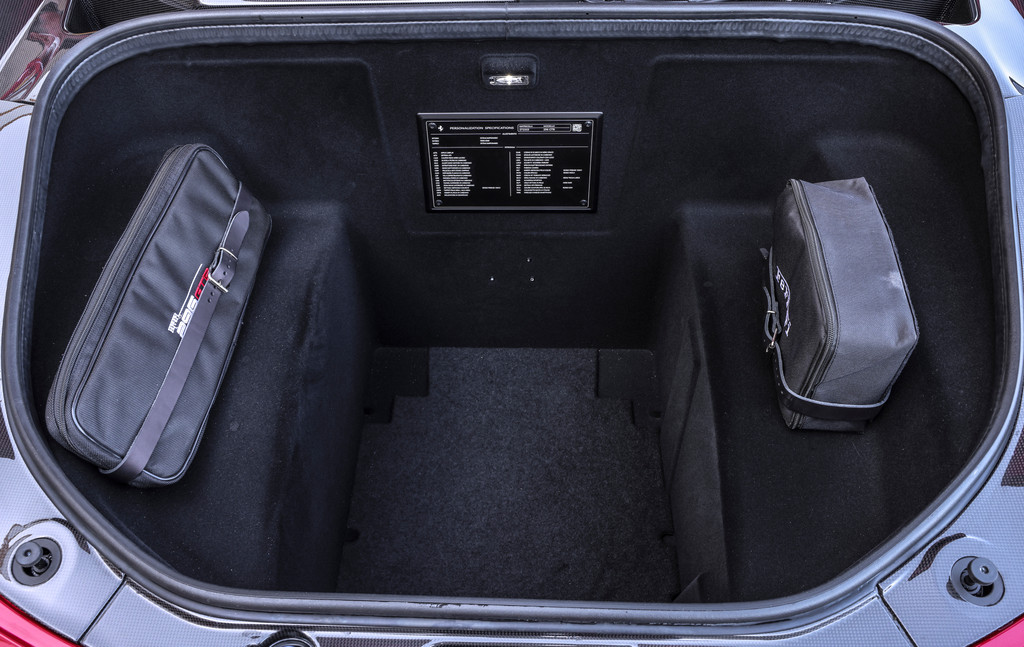
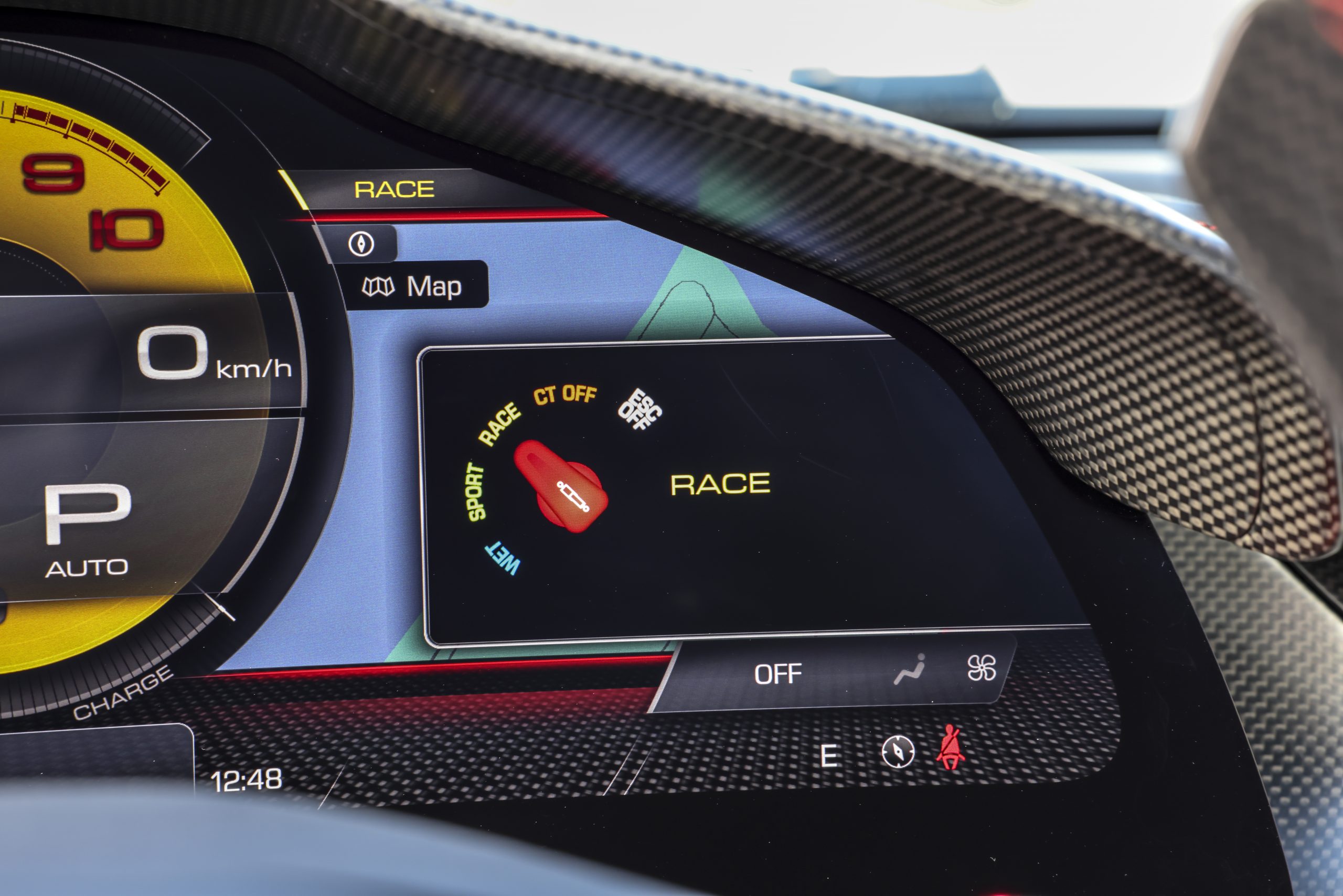
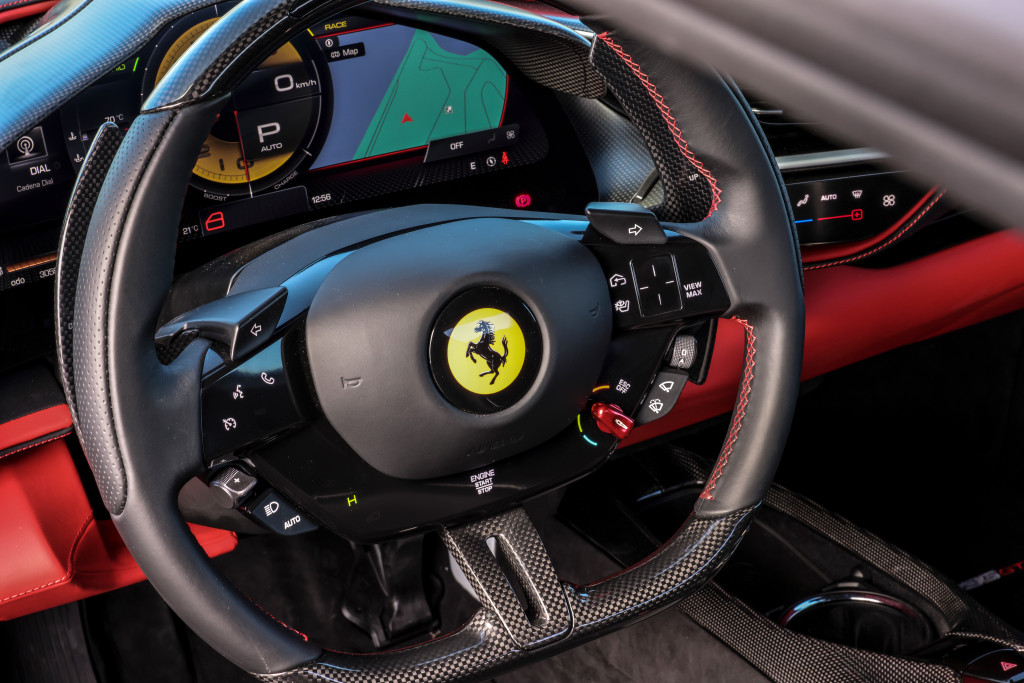
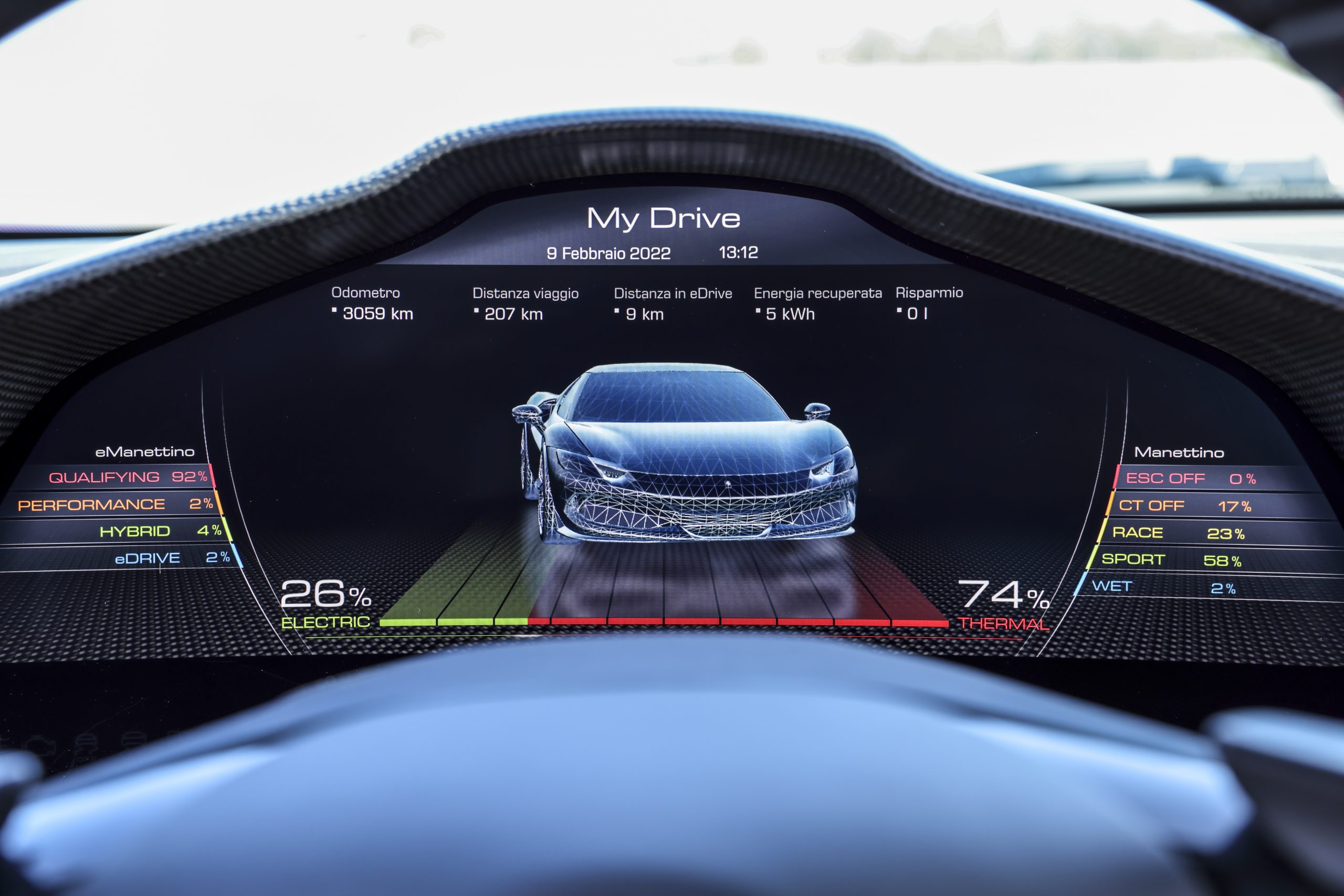
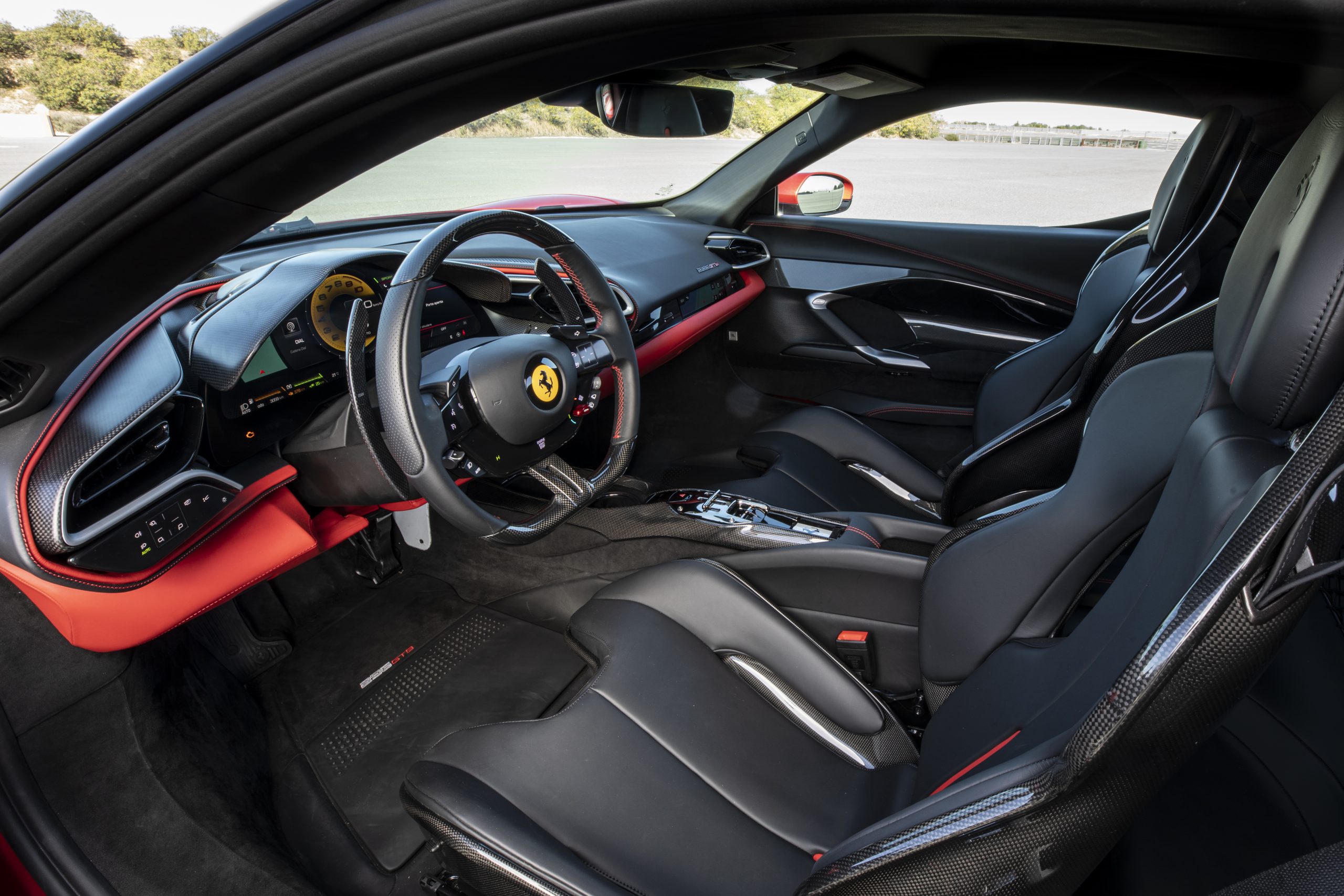
The graphics are clear and for the most part the operation is intuitive, though there’s a lot of switches on the steering wheel with a new second switch (eManettino) for the drivetrain settings. Let’s go through those. There’s eDrive for pure electric drive; Hybrid, blending electric and combustion power for maximum efficiency; Performance, where the engine is always on and the battery will charge up; and Qualify, which provides maximum performance at the expense of the battery state of charge. In addition, there’s a strange set of sound studio slider switches on the centre console, which control the transmission settings, but aren’t the most logical things.
Press that button
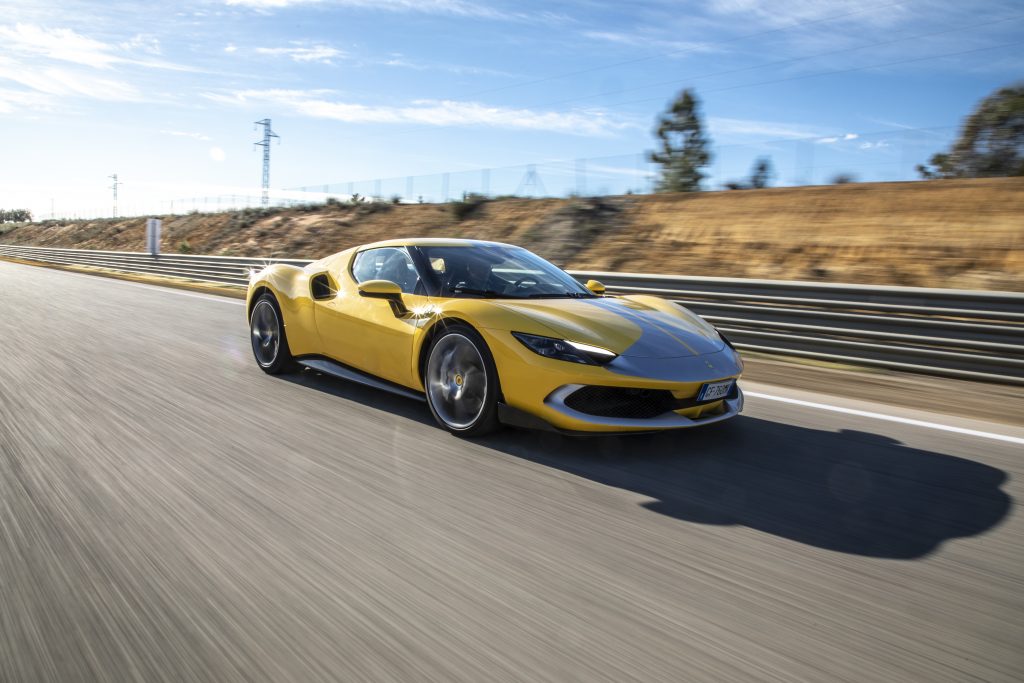
Start it up and the V6 gives a shrill blast until settling down. Ferrari says the engine note is like a piccolo (small) V12, but that’s only in very short transients, the rest of the time it sounds like a V6, industrial and shrieky. The right-hand steering-column paddle engages first and the car pulls away in Hybrid using its 6kWh of battery power, though when that energy source is quickly exhausted, the engine starts.
The steering feels direct, darty almost and we learn that in development Michelin had to soften up the carcasses of the front tyres and harden up those of the rears to calm the car’s lightning responses, which given the almost 60 per cent rear weight bias, feels almost counterintuitive.
On the twisting roads round the Monteblanco circuit near Seville in Spain, this Ferrari takes a bit of getting used to. There’s the power, of course, which simply catapults the car along even a short straight with little sense of effort or reality, such that when you look down at the speedometer, you double-take in wonder at the figure displayed – just how did that happen? But there’s also the sense of being managed, reined in, even.
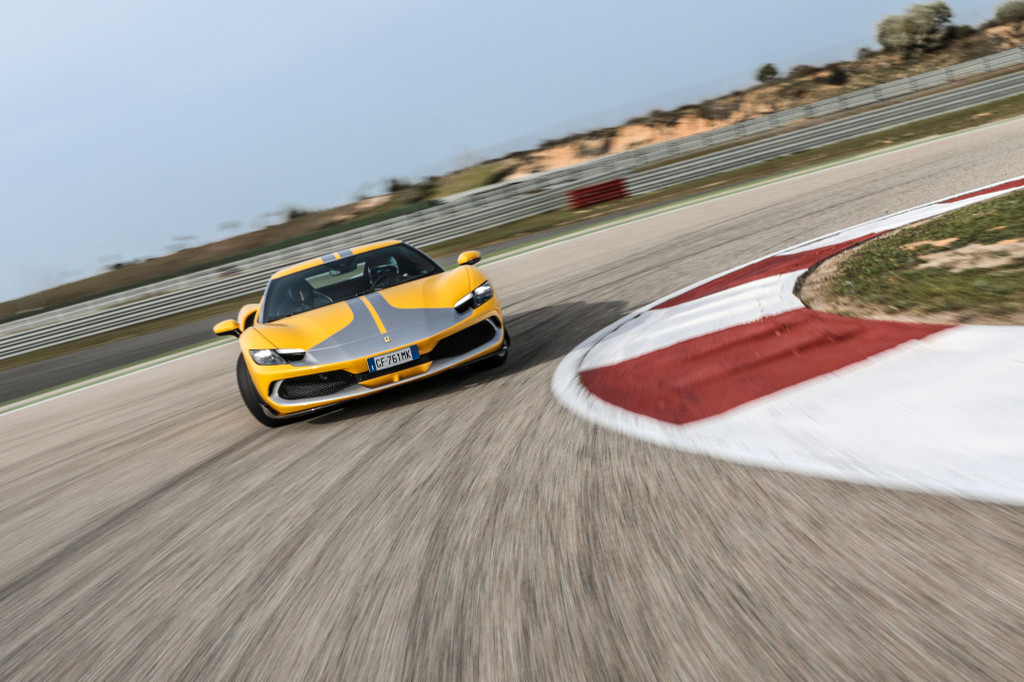
This Big Brother feeling was present on Ferrari’s predecessor plug-in, the SF90 Stradale (reviewed here) and while it’s less pronounced with the 296 GTB, it’s there nonetheless. The electronic differential, the brake-by-wire traction and stability control are joined by the battery into which the car can funnel your over-exuberance without you much noticing. Such is the crushing power of the drivetrain, you’re seldom aware of there not being the full 813bhp when you press the throttle. Indeed, it’s highly debatable exactly when and for how long you get the full beans in this car since that all depends on the battery state of charge.
What are quite brilliant, though are the carbon-ceramic anchors, which combine regeneration charging and friction linings in seamless and almost reality-defying stopping. Also quite uncanny, is the way this car turns into corners, feeling more like a driving game than a car. For those of us more used to the tail-end terror of the Eighties supercar where slow-in, fast-out cornering was a necessity, this feels almost unnatural.
Marc Gené, Le Mans winner, former F1 driver, F1 commentator and Ferrari test driver took us round the Monteblanco circuit showing just how much grip there is, or isn’t in some cases. With what is termed “the evolved grip estimator”, the Ferrari’s stability systems will allow you to pull off that race driver’s trick of braking hard right into the apex of a bend then accelerating out. Don’t try this at home, though, as it isn’t an easy thing to master. Gené gives us a masterclass, all the while chatting amiably away. He doesn’t seem at all fazed by the car’s electrifying performance or its lack of steering feedback.
“It is a racing driver’s Ferrari,” he said.
Conclusion
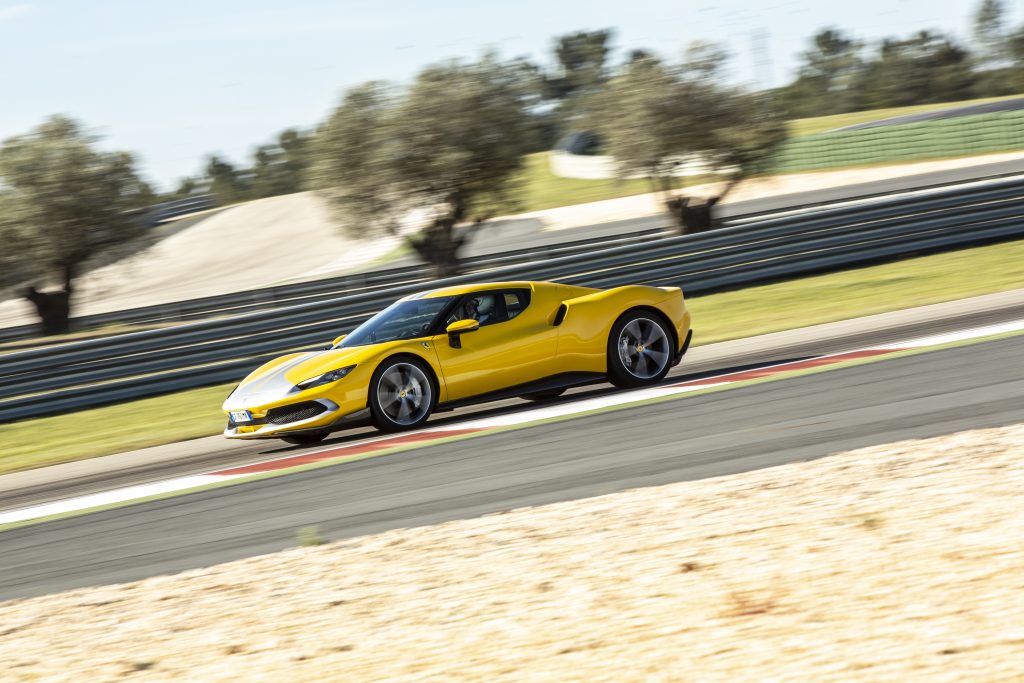
It’s true to say it’s a racing driver’s Ferrari, but it’s also a gamer’s Ferrari. In the computer simulations, though, the skills of easing a car into a bend, husbanding weight against grip, and engine power against the transmission, is of less value than the stark calculation of just how fast you dare push this car through a turn while being confident that if you get it wrong, the systems will (mostly) sort it out for you.
It’s a heady and expensive brew. Our car came with the lightweight Fiorano pack which costs £25,920. Add in some extras such as the £7,104 special paint finish, a £14,400 racing stripe, or a £19,200 set of carbon-fibre wheels and you could easily be looking at a cost the far side of £300,000.
You have to admire the 296 GTB, but that’s mostly for what it can do rather than the way it goes about it. In truth, I found this car more disconcerting than desirable.
Just like the 250LM before it, the 296 GTB is a controversial step into the future.
2022 Ferrari 296 GTB specifications
Price: £241,550, plus Fiorano pack at £25,920
Engine: 120-degee V6, 2,992cc, twin-turbo petrol
Power: 654bhp
Electric powertrain: 164bhp/122kW motor, with 7.4kWh gross lithium-ion battery
Maximum system power/torque: 818bhp @ 8,000rpm/546lb ft @ 6,250rpm
Gearbox: 8-speed dual-clutch semi-automatic, rear-wheel drive
Kerbweight: 1,560kg with full tank without a driver
0-62mph: 2.9 seconds
Top speed: 205mph
Fuel consumption: 21.7mpg
Electric range: 15.5 miles
Charging times to 1-100 per cent: one hour on 7.4kW home wall box, 36 minutes on an 11kW street charger
CO2 emissions: 149g/km
VED: £210 first year, then £145, plus £335 luxury car tax for years 2-6
Warranty: four years unlimited mileage with an additional five years cover available for £4,080
Read more
Revenge is sweet: Maserati MC20 review
Ineos Grenadier review: Splashdown! The new 4×4 is made of tough stuff
Review: The David Brown Mini Remastered Oselli Edition is a miniature marvel



